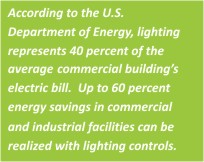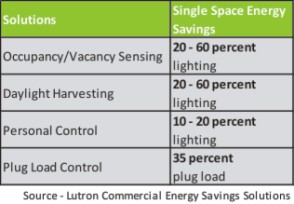
Lighting Controls have come a long way!
Back in the day, lighting controls were pretty simple. The switch was flipped “on” or “off”. That all works well if not for the human factor. What human factor? The,”I’m too busy to pay enough attention to turn the lights off when I should,” human factor. Hey, but today, technology can come to the rescue. Society has come a long way!
Smart Switches
New technologies are smart. Perhaps one of the most popular technologies today is occupancy/vacancy switching (occupancy sensors). Technology can turn the lights on and off.
Occupancy sensors are sensing/switching devices that serve three basic functions: automatically turn lights on when a room becomes occupied, keep the lights on while the controlled space is occupied, and turn the lights off within a preset time period when the space becomes vacated.
These devices consist of a motion detector, an electronic control unit, a controllable switch, and a power supply. The motion detector uses ultrasonic, passive infrared, or dual technology (both) sensors to detect the presence or absence of occupants. This signal activates a switch depending on the presence or absence of occupants.
Areas of intermittent occupancy, such as conference rooms or rest rooms, are well suited for occupancy sensing. Use of occupancy sensors can result in energy cost savings of 13-90 percent if they are properly calibrated, wired correctly, and located correctly.
Hey, it’s too bright in here!
Dimmers, or dimmer switches are used to adjust the brightness of fixtures depending on the user requirements, tasks, or activities performed in the space. Lights can be dimmed manually or automatically.
Controlling the brightness of fixtures has been shown to reduce lighting energy costs on a 1:1 ratio while enhancing the occupancy experience. Light sources use less energy when dimmed and using this technology can save 9–10 percent of electrical usage over a standard on – off switch. Dimming also increases lamp life, which saves maintenance costs.
It is critical to select a dimmer that is compatible with the light source and that the fixtures being driven are dimmable.
Mother Nature to the Rescue!
Another popular technology is daylight harvesting. In occupied spaces where exterior windows or skylights are present, daylighting controls can be used to allow natural light into a space while controlling light sources of” or at least dimmed to a lower level. Daylighting improves a building’s overall energy performance by not only reducing lighting energy, but also reducing cooling equipment sizes and usage.

How about some planning?
More sophisticated lighting controls can be accomplished when the aforementioned technologies are combined with scheduling through programmable lighting panels or building automation systems.
In today’s building environment, a technology or a control probably exists to accomplish a desired task. Here is a table showing the opportunities that exist today with some simple technologies. So, get with the program and save some energy!




